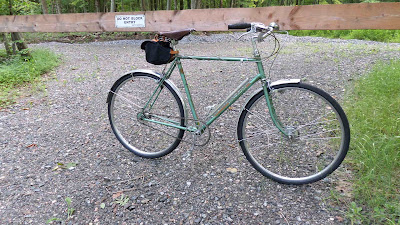Prologue: Get the Dents out First
I have written before about removing dents from steel and stainless steel bike fenders.
The process is fairly simple. You make a fender block by tracing the profile of your fender onto the block. Sometimes fenders have different profiles at different places (e.g., the fender is deeper farther in, while has a flatter profile near the tail).
After you have the block cutaways made, you take a round piece of wood matching what you cut away and put it inside the fender. You gradually work out the dents using the wood pieces and a hammer/mallet.
I. Don't Overlook Your Drill Press!
Now, let's say you want to buff up those aluminum or stainless steel fenders. Sure, you could work them by hand over-and-over until they shine. But if you happen to have even a basic drill press, you already have a tool that can speed up the job considerably...
The drill press is a much more versatile tool than people often credit. Of course, with a carbide bit, they can be used to drill out metal pieces. But put a metal bristle brush tool in the chuck, and suddenly you have a powerful rust removal tool... Or, strap in a donor axle and you can refresh damaged hub cones for an old Schwinn... or English cones for an old Raleigh.
The drill press can also help you with your fenders. Look for a cloth wheel and mandrel kit in your local hardware store. They cost a few dollars and turn your drill press into a versatile buffer. It excels are larger jobs like aluminum or stainless steel fenders, but is gentler than the rapid-speed bench grinder with a buffer wheel on it. If you're careful, you can also buff chrome on a drill press wheel set to a medium or slow speed.
II. Get Your Polishing Compound...
You don't need piles and piles of different polishing compounds to make this work well for you. My suggested list of compounds for a good, basic kit are:
- Black polishing bar (Emery) - a relatively aggressive, coarse compound for deep scratches on stainless steel or bare steel. You won't need this one a lot, but it's nice to have if you get a rough project.
- White polishing bar (called "Diamond" or "White Rouge") - a medium-fine compound good for starting the high-luster buff on aluminum or stainless steel.
- Red polishing bar (Rouge) - a good, fine compound for final or semi-final finishing.
- Simichrome polish - a high-quality polish that excels with stainless steel, aluminum, and chrome. (it's really versatile stuff ). Good finisher after a pass with rouge bar.
- A good paint-friendly polish like Maguire's or NuFinish. Gentler than Simichrome good for that light clean-up on painted surfaces or high-shine surface.

You will see other compounds (e.g., Brown "Tripoli" or Green "General") - I don't think you necessarily need them. In fact, you'll rarely use the black emery compound and will probably use a lot of the red rouge and the Simichrome. Only some projects have those deep scratches on bare metal suited to something coarser than the white compound. But many projects need that nice, final shine you get from red rouge or Simichrome, for example.
III. Getting Used to the Drill Press Buffer
Set the drill press to medium or slow speed. Put a little of the compound you need on the cloth wheel and begin working the fender gently and evenly from one end, taking care not to bear down on or round-off corners and edges. When the wheel begins to run dry a bit, refresh the compound on the wheel. Work each area once, don't buff the same area over and over. Don't bear down hard or heat the fender up too much. You'll get the hang of it fairly quickly.
Start coarse and go finer. Don't feel the need to always start with emery bar - it's perfectly fine to start fine and go finer. In fact, my most-used compounds are red rouge and Simichrome. I need white bar once in awhile, and black emery only for bare stainless or steel that is really scratched-up. I go through three bars of red for every one white, and five bars of red for each black. I follow the red with Simichrome on stainless, aluminum, bare steel, or chrome.

Painted fenders are tricky. Hitting one spot hard or heating the fender up will damage paint. With painted fenders, my first choice is to work by hand with a good car polish like Maguire's or NuFinish. But for some tough cases where the paint is something durable (e.g., Raleigh black), and where something tougher is needed, I use the drill press buffer. In those cases, I set the machine speed to slow and work very gently using my softest cloth wheel and only car polish. This requires care and attention, but can produce a good result in not much time.
IV. So in Summary, Don't Go Straight to the Bench Grinder...
People often think buffing wheels are the domain of a bench grinder. Some of the better grinders can do a good job, but I much prefer the slower drill press running an open, cloth buffing wheel. The drill press wheel does not have the guards that get in the way of manipulating the piece you are polishing, and something like a 5-speed drill press gives you good choices in how fast you want to spin the buffer. Most of the speeds are slower than the bench grinder and give you a versatile polishing tool (not to mention a cone-smoothing tool, hole-maker, rust-removing brush, etc.).














































